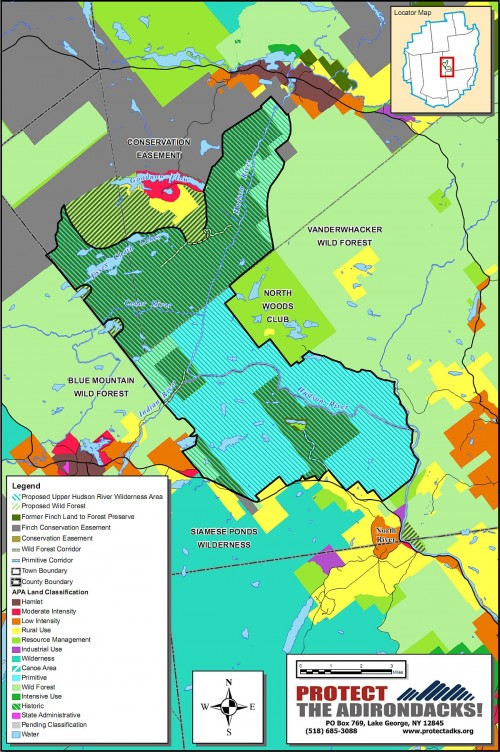Park Agency Board & Public Would be Cut Out of Review of Clear-Cuts
 RAY BROOK, N.Y. – The Adirondack Park Agency is considering a plan to eliminate the requirement for a formal environmental review before the state grants permission to undertake major clear-cutting in the private forests of the Adirondack Park.
RAY BROOK, N.Y. – The Adirondack Park Agency is considering a plan to eliminate the requirement for a formal environmental review before the state grants permission to undertake major clear-cutting in the private forests of the Adirondack Park.
The damage done to the forests and waters of the Adirondack Park by widespread clear-cutting was the reason why the public voted to protect the park’s public forests via the NYS Constitution, declaring them to be “forever wild” in 1894. Private forests have been under the jurisdiction of the Adirondack Park Agency since 1971.
“The Adirondack Park is the first region of the United States where we learned what awful damage de-regulated clear-cutting can do,” said Diane W. Fish, Executive Director of the Adirondack Council. “Our forests, our water quality and wildlife all suffered. All of the park’s major rivers got muddy and slow. The Erie Canal and Hudson River were in danger of drying up.”
“Public notice of plans to clear-cut a forest would be eliminated under this proposal,” said Roger Downs, Director of Conservation for the Sierra Club, Atlantic Chapter. “That would make it impossible for the public to react before the trees start to fall. No one outside the agency will know until after the permit is issued. Once a staff member declares an application is „complete’ he or she will have only 10 days to issue a final clear-cutting permit. If the APA doesn’t act within 10 days, the applicant can demand automatic approval under the current rules.”(Section 809-6a)
“Worse yet, the new plan contains no restrictions on how many acres may be clear-cut under a fast-track permit,” Fish of the Council explained. “So it is possible that hundreds, or even thousands, of acres could be cut bare without public notice or participation.”
“If that were not bad enough, these permits would never expire,” she said. “Once a permit is issued, the landowner is free to clear-cut that parcel over and over again. There are no limits to allow for regrowth and no requirement for future site visits by agency staff.”
The Adirondack Park Agency Board of Commissioners is expected to vote on the fasttrack permit proposal at its January 10 meeting. The organizations urged the public to contact the agency and ask it to reject the plan.
Currently, timber companies and other landowners must get a permit from the Adirondack Park Agency for any clear-cut above 25 acres on non-wetlands. Clear-cutting is the practice of removing all of the trees from a parcel of land. An acre is about the size of a football field without the end zones.
In order to get that permit, current applicants must undergo a formal environmental review that includes public notice and public participation and approval by the Adirondack Park Agency’s Board of Commissioners. The new plan would eliminate those requirements by allowing agency staff to issue permits, without a vote by the board of commissioners.
This new fast-track approval process would apply even to lands where the state has purchased a conservation easement to ensure that the lands are managed responsibly and sustainably.
“Frankly, we are not persuaded that anyone really needs this expedited, general permit,” said Fish. “Over the past 20 years, timber companies have only requested permission for major clear-cuts from the park agency three times. All three permits were granted. All three resulted in numerous public complaints about abuse of the forest. People get mad about smaller ones too, much smaller than 25 acres.”
“If anything, that proves that the threshold for permits is too lax, and ought to be lower than 25 acres,” said Adrienne Esposito, Executive Director of Citizens’ Campaign for the Environment. “Large clear-cuts in the Adirondack Park tend to outrage the public. Issuing permits in secret won’t hide a landscape devoid of trees, covered only in stumps and mud and tire tracks. It won’t stop the mud and silt from drifting downstream, burying trout spawning beds along the way.”
“Perhaps clear-cutting is a tool that some timber companies favor to regenerate a certain species of tree,” said Fish. “But in places like the Adirondack Park, with such steep slopes and thin soils, it can do real damage when it is not tightly supervised. Going from a formal review to having staff issue fast-track permits is not tight supervision.”
Under the plan, park agency staff members could accept as adequate almost any forest management plan, including those overseen by the timber industry (Sustainable Forestry Initiative) rather than independent third parties (Forest Stewardship Council).
The Adirondack Council is a privately funded, not-for-profit organization dedicated to ensuring the wild character and ecological integrity of New York’s 9,300-square-mile Adirondack Park. Founded in 1975, the Council carries out its mission through research, education, advocacy and legal action. Council members live in all 50 United States.
Citizens Campaign for the Environment (CCE) was formed in 1985 by a small group of concerned citizens who recognized the need to provide public involvement to advance stronger environmental policy. Today, after 25 years as a not-for-profit, non-partisan advocacy organization, CCE has grown to an 80,000-member organization with offices in Farmingdale, NY, White Plains, NY, Albany, NY, Syracuse, NY, Buffalo, NY, and Hamden, CT. CCE continues to work to empower the public by providing members with opportunities to participate in the political process and thereby advance a strong environmental agenda.
The Sierra Club’s mission is to explore, enjoy, and protect the wild places of the earth; to practice and promote the responsible use of the earth’s ecosystems and resources; to educate and enlist humanity to protect and restore the quality of the natural and human environment; and to use all lawful means to carry out these objectives.
 The New York State Department of Environmental Conservation (DEC) will begin to deliver 80 tons of lime to an acidified lake in the Five Ponds Wilderness Area north of Stillwater Reservoir in the town of Webb, Herkimer County today, DEC Regional Director Judy Drabicki announced.
The New York State Department of Environmental Conservation (DEC) will begin to deliver 80 tons of lime to an acidified lake in the Five Ponds Wilderness Area north of Stillwater Reservoir in the town of Webb, Herkimer County today, DEC Regional Director Judy Drabicki announced.







